Ramón de Campoamor y Campoosorio facts for kids
Quick facts for kids
Ramón de Campoamor
|
|
|---|---|
 |
|
| Born | Ramón María de las Mercedes Pérez de Campoamor y Campoosorio 24 September 1817 Navia, Spain |
| Died | 11 February 1901 (aged 83) Madrid, Spain |
| Language | Spanish |
| Nationality | Spanish |
| Genre | Poetry |
| Seat E of the Real Academia Española | |
| In office 9 March 1862 – 11 February 1901 |
|
| Preceded by | José del Castillo y Ayensa |
| Succeeded by | José Ortega Munilla |
Ramón María de las Mercedes Pérez de Campoamor y Campoosorio (born September 24, 1817 – died February 11, 1901), known as Ramón de Campoamor, was a famous Spanish poet and philosopher. He is known for his realistic style of writing.
Ramón de Campoamor's Life
Ramón de Campoamor was born in Navia, a town in Asturias, Spain, on September 24, 1817. He first thought about becoming a Jesuit priest. However, he changed his mind and decided to study medicine in Madrid.
After his studies, he became interested in politics. He supported the Moderate Party, a political group that believed in a balanced approach to government. He held several important jobs, serving as governor in cities like Castellón de la Plana, Alicante, and Valencia. Campoamor believed in a calm and fair way of governing. He did not support extreme changes or going back to old ways.
His Poetic Journey
Campoamor started his writing career as a poet in 1840. His first collection of poems, Ternezas y flores, was published in Madrid. These poems were about nature and love, and people admired his writing skill. He continued to publish more poetry, including Ayes del Alma (1842) and Fábulas morales y politicas (1842). These works helped him become even more well-known.
He also wrote a long poem called Colón (1853), which was about Christopher Columbus. However, this epic poem was not as popular as his other works. Campoamor also wrote plays, such as El Palacio de la Verdad (1871) and Dies Irae (1873). While these plays were interesting experiments, they were not very dramatic.
What are Doloras?
Campoamor was very interested in deep questions about life and the world, which is called metaphysics and philosophy. He wrote several books on these topics, like La Filosofia de las leyes (1846). These studies helped him create a new type of poetry he called "doloras," "humoradas," and "pequeños poemas."

The first collection of Doloras came out in 1846. It is a bit tricky to explain exactly what a dolora is. Some people describe it as a short, symbolic poem that teaches a lesson. It combines the cleverness of an epigram, the sadness of a mournful song, the short story of a ballad, and the deep meaning of a fable.
Campoamor himself said that a dolora is a "dramatic humorada," meaning a humorous poem with a story. He also said a "pequeño poema" is just a longer dolora. These definitions can be a bit confusing. Basically, Campoamor took an old type of short, wise poem and gave it a new name.
In his Doloras, Campoamor showed his best writing skills. He was good at using irony, grace, and sadness. He would take an everyday idea and turn it into a perfect, small poem of strong feelings. By writing these short pieces, he avoided writing too much, which can sometimes make poems less powerful. He liked to write in a slightly sad way, and many writers who followed him copied this style.
Ramón de Campoamor passed away in Madrid on February 11, 1901.
See also
 In Spanish: Ramón de Campoamor para niños
In Spanish: Ramón de Campoamor para niños

